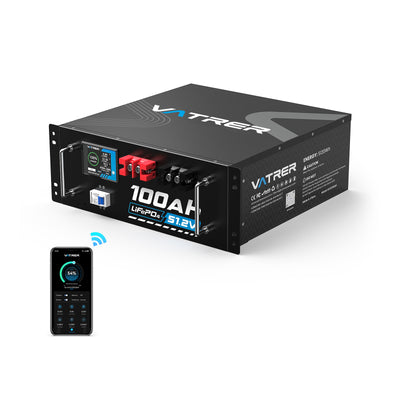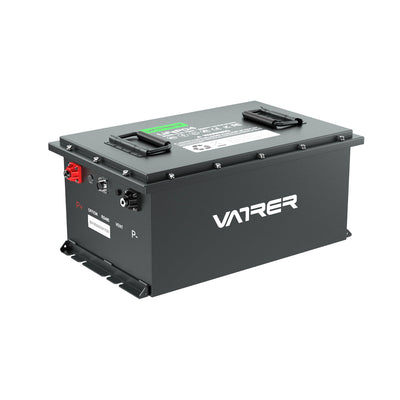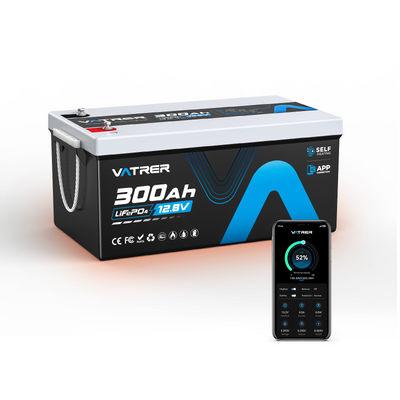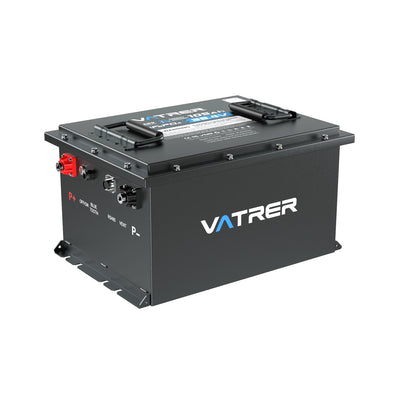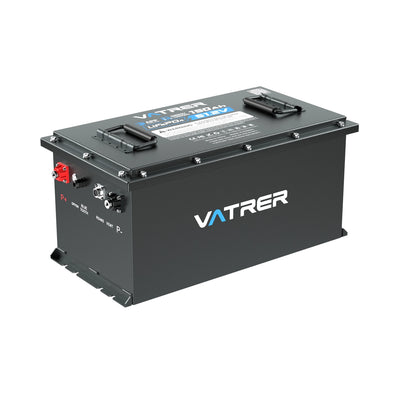
How Much Does It Cost To Replace Golf Cart Batteries
Golf carts are a popular way to get around the golf course, move through residential neighbourhoods, or travel inside gated communities, but their overall performance ultimately depends on having a solid, well-sized battery pack.
When you reach the point where a golf cart battery replacement is needed, knowing the cost to replace golf cart batteries helps you plan properly. Whether you are updating a Club Car, EZGO, or Yamaha golf cart, total expenses can sit anywhere between $400 and $4,000, depending on battery chemistry, system voltage, and any installation work required.
This guide explains typical golf cart battery costs, compares the main types of golf cart batteries such as lead-acid, AGM, and lithium golf cart batteries, and shares practical tips to get the most value from your investment.

What Are the Costs of Golf Cart Battery Replacement Options?
Selecting golf cart replacement batteries is a bit like choosing the right engine for your vehicle – it influences performance, driving range, and budget. The overall cost to replace your pack depends largely on the battery technology, and each option aligns with different spending levels and usage habits. Below is a summary of price ranges and core features, whether you are planning a Club Car golf cart battery replacement or an EZGO golf cart battery replacement.
| Battery Type | Price per Battery | Batteries per Cart | Estimated Pack Cost | Typical Lifespan | Maintenance Requirements |
|---|---|---|---|---|---|
| Flooded Lead-Acid | $100-$200 | 4-8 | $400-$1600 | 3-5 years | High (watering, cleaning) |
| AGM | $200-$350 | 4-8 | $800-$1400 | 4-6 years | Low |
| Lithium-Ion (LiFePO4) | $1,500-$4,000 | 1 | $2,000-$4,000 | 8-10 years | None |
- Flooded Lead-Acid Batteries: The lowest-cost solution, suited to occasional drivers or older models such as Yamaha gas golf cart battery replacement. At roughly $100-$200 per unit, a 48 volt golf cart battery replacement using 4-8 batteries totals about $400-$1,600. Expect 3-5 years of service and ongoing tasks like topping up water and cleaning terminals. In many ways, they resemble an older vehicle – inexpensive to buy but demanding in terms of upkeep.
- AGM Batteries: Positioned in the mid-range, AGM batteries are typically $200-$350 each, leading to $800-$2,800 for a full set. They usually last 4-6 years, and the sealed design significantly reduces day-to-day maintenance and the risk of spills. Think of them as similar to a hybrid car – more efficient and convenient than entry-level options, though not the absolute top tier.
- Lithium-Ion (LiFePO4) Batteries: These come in at around $1,500-$4,000 per battery. With an expected lifespan of 8-10 years and no regular maintenance, they behave more like an electric vehicle – higher upfront cost but strong savings and convenience over time. For instance, a Vatrer 48V golf cart lithium battery in the $1,500-$2,500 range can deliver more than 4,000 charge cycles, enough for many seasons of 18–36-hole rounds.
These base figures help you set a starting budget for golf cart battery replacement, but there are additional cost factors to consider. The next section looks at those extra charges.
Hidden Costs of Golf Cart Battery Replacement You Need to Know
Beyond the sticker price of the batteries themselves, other items can influence your total golf cart battery costs. Accounting for these early on gives you a more realistic battery replacement budget, whether you are updating a Club Car, EZGO, or another brand.
- Installation: Having the batteries installed by a qualified technician – recommended for both safety and proper configuration – generally costs $75-$500. In large urban centres such as Los Angeles, labour can run $200-$500, while rural regions often fall closer to $75-$200. If you are converting from lead-acid to lithium with higher system voltages, added wiring and setup work can increase the bill.
- Charger Compatibility: Moving to lithium golf cart batteries typically requires a charger designed for lithium chemistry ($100-$600). For example, a 58.4V 18A charger matched to a 48 volt golf cart battery replacement supports safe, efficient charging in about 5-6 hours. To help trim your overall replacement spending, Vatrer supplies 36V, 48V and 72V golf cart kits, each bundled with a compatible dedicated charger.
- Accessories: Traditional lead-acid systems may need extra items such as watering kits ($50-$100) or voltage gauges ($50-$200). Many lithium-ion solutions, including Vatrer packs, integrate Bluetooth monitoring, which can reduce the need for separate accessories.
- Disposal Fees: Proper recycling of lead-acid batteries can add $10-$30 per unit, depending on local regulations and recycling programmes.
- Retrofit Costs: Converting older carts to lithium-ion, such as upgrading an EZGO golf cart battery replacement from 36V to 48V, may require updated controllers or new wiring looms, typically adding $200-$600.
These extra line items can shift your total budget, but picking the right battery technology can help cut long-term ownership costs.
Which Golf Cart Battery Type Suits Your Replacement Needs?
Choosing a golf cart battery type for replacement is similar to selecting the right club for a specific shot – each option has situations where it shines. The comparison below looks at common golf cart battery replacements used in popular models from brands like Yamaha and Club Car, helping clarify which battery may be best for your cart.
| Feature | Lead-Acid | AGM | Lithium-Ion (LiFePO4) |
|---|---|---|---|
| Initial Cost | Low ($100-$1,600) | Medium ($800-$2,800) | High ($1,500-$4,000) |
| Service Life | 3-5 years | 4-6 years | 8-10 years |
| Maintenance Level | High (watering, cleaning) | Low (sealed construction) | None |
| Charging Time | 6-8 hours | 4-6 hours | 1-3 hours |
| Weight | Heavy (150-200 lbs) | Moderate (120-160 lbs) | Light (60-100 lbs) |
| Environmental Impact | High (toxic, less recyclable) | Moderate | Highly recyclable, lower impact |
- Lead-Acid: Best for owners working with a tight budget who only use their cart occasionally on weekends. The low entry cost is attractive for older Yamaha gas golf cart battery replacement, but the combination of regular maintenance and shorter lifespan limits the overall value over time.
- AGM: A strong choice for moderate users who want less day-to-day upkeep. The sealed design avoids spills and acid exposure, which is particularly helpful for EZGO golf cart battery replacement. However, AGM still cannot match lithium-ion for longevity.
- Lithium-Ion: An excellent fit for regular users or contemporary carts such as Club Car models. Their high efficiency, lighter weight and improved environmental profile make them a compelling option for a 48 volt golf cart battery replacement, especially on hilly or long-distance routes.
Why Lithium Golf Cart Batteries Transform Your Battery Replacement Experience
Switching to lithium golf cart batteries is comparable to moving from a basic flip phone to a modern smartphone – you gain more capability, less hassle, and a noticeably better experience overall.
If you are planning a golf cart battery replacement, lithium-ion technology delivers high-level performance and works particularly well for frequent users of brands like Club Car, EZGO or Icon. Here are the main reasons they offer such strong value:
- Longevity: With roughly 4,000-5,000 cycles, LiFePO4 packs typically provide 8-10 years of service. This reduces how often you need a full replacement and lowers long-term costs.
- Efficiency: With capacities around 100-200 Ah, lithium batteries can extend driving range by roughly 15-25 miles per charge. Being up to about 50% lighter than comparable lead-acid setups, they also improve acceleration and handling, which is helpful on courses with steep climbs.
- Zero Maintenance: No watering, equalising charges or frequent cleaning are required, making lithium an attractive option for regular or professional golfers. Using a Vatrer 48V 105Ah battery with Bluetooth monitoring, you can also track charging progress and voltage in real time.
- Safety: Integrated Battery Management Systems (BMS) help protect against overcharging, short circuits and thermal runaway. LiFePO4 chemistry is inherently more stable, offering an added layer of safety in hot weather compared with some other lithium formulations.
- Eco-Friendly: Up to about 95% recyclable, LiFePO4 batteries tend to have a lower toxicity profile than lead-acid batteries, which contain lead and sulphuric acid and must follow specific disposal rules such as EPA Battery Recycling Guidelines.
What Impact the Cost to Replace Golf Cart Batteries?
Several key elements influence golf cart battery costs – much like ingredients in a recipe, each component contributes to the final total. Understanding them makes it easier to plan a realistic replacement budget for Club Car, EZGO, Yamaha, or other carts.
- Battery Type: Lead-acid batteries are the least expensive upfront, but the shorter life and frequent replacements increase total ownership cost. Lithium golf cart batteries cost more initially but often save money over the long term.
- Voltage and Capacity: Higher system voltages (36V, 48V, 72V) and larger capacities (100-200 Ah) push costs upward. For example, a 72V lithium-ion system for an Icon golf cart battery replacement may cost $2,000-$3,000, whereas a comparable lead-acid setup might fall between $1,000-$2,000. For a 48 volt golf cart battery replacement, this could mean four 12V lead-acid batteries or a single 48V lithium pack – just ensure your controller is compatible.
- Number of Batteries: Lead-acid and AGM systems generally use 4-8 individual batteries, while lithium-ion options often use one integrated pack, which simplifies installation and may lower some labour-related costs.
- Brand and Warranty: Well-known manufacturers like Vatrer provide warranty service that covers defects and performance for several years, in contrast to many lead-acid packs that only carry a 1-2 year warranty.
- Regional Variations: Installation costs can differ significantly by location. In major metropolitan areas such as Los Angeles, typical labour charges range from $200-$500, while in smaller or rural communities, average installation fees are closer to $75-$200.
- Installation Complexity: Moving from lead-acid to lithium can require additional work, such as rewiring or controller reprogramming ($200-$600), especially with older EZGO models upgrading from 36V to 48V systems.
How to Extend Your Golf Cart Battery Replacement Investment
Looking after your batteries properly helps your golf cart replacement batteries last longer, similar to regular servicing on a car. The following practices increase value whether you use lead-acid, AGM or lithium golf cart batteries:
- Charge Smartly: Try to recharge when the battery pack reaches about 50% state of charge. Avoiding deep discharge helps protect all types of golf cart batteries. For lithium batteries, using a smart charger with automatic shut-off is recommended to prevent overcharging.
- Lead-Acid Maintenance: Inspect electrolyte levels monthly, topping up with distilled water as needed, and clean terminals with a baking soda and water mixture to limit corrosion. This routine is especially important for Club Car golf cart battery replacement setups that still rely on lead-acid packs.
- Lithium-Ion Care: Always use a charger rated for lithium-ion and, where available, monitor performance using Bluetooth apps to view statistics such as charge cycles, voltage, and state of charge. Avoid exposing batteries to extreme temperatures (above 140°F or below -4°F) to help preserve capacity.
- Storage: Park and store the cart in a cool, dry place to minimise temperature-related wear. Excessive heat speeds up degradation, particularly for lead-acid batteries.
- Avoid Mixing Batteries: Many owners ask, "Can I use four 12V batteries in my 48V golf cart?" The short answer is yes, as long as all four batteries are new and identical. Combining old and new units leads to imbalances that reduce performance and reliability. If one battery in a set fails, it is best practice to replace the entire set together, though this approach can be costly and is generally not recommended unless necessary.
- Limit Heavy Loads: Avoid overloading the cart, for example by carrying too many passengers or towing heavy loads up steep inclines, as this puts extra strain on the battery pack.
Conclusion
With a clearer understanding of golf cart battery replacement, you are better prepared to choose the right solution for your Club Car, EZGO, Yamaha or Icon vehicle. In general, golf cart battery costs fall between $400 and $4,000, influenced by battery chemistry, the number of batteries required, and installation factors such as voltage level (36V, 48V, 72V) and any retrofit work.
Visit the Vatrer shop to access new-user offers and select a battery replacement that delivers dependable, long-lasting performance for your golf cart use, whether on the course or around the community.
FAQs
Compatibility mainly depends on your cart’s system voltage and the type of controller it uses. For example, many Club Car or EZGO golf cart battery replacement projects involve 48V systems, which can generally be configured to work with lithium-ion batteries.
That said, older carts may require a controller upgrade or wiring changes to cope with lithium’s higher efficiency and discharge capability. Always confirm the voltage rating in your owner’s manual and consult a qualified technician to verify controller and system compatibility before upgrading.
Lithium-ion (LiFePO4) batteries are considered safe when installed and used correctly, thanks to their built-in Battery Management Systems (BMS), which help prevent overcharging and thermal runaway.
Still, there are a few precautions to follow: always use a charger designed for lithium batteries to avoid incorrect voltage or charge profiles. During installation, ensure polarity is correct and all connections are tight and secure to reduce the risk of short circuits – ideally, this work should be carried out by a professional.
Store batteries in a cool, dry environment (below 140°F) to limit heat-related wear. Unlike flooded lead-acid batteries, LiFePO4 units do not release hazardous gases, but you should still avoid dropping or damaging the case, as mechanical damage can compromise safety. Vatrer batteries are equipped with low-temperature cut-off and short-circuit protection for added peace of mind.
Yes, lithium golf cart batteries can handle challenging weather conditions, provided they are used within their recommended temperature range. LiFePO4 batteries typically operate well between -4°F and 140°F, and they often retain performance better in heat than many lead-acid batteries.
For cold regions, choose batteries with low-temperature cut-off, such as a Vatrer golf cart battery model that pauses charging below specific low temperatures to avoid damage. In hot climates, avoid leaving the cart in direct sun for long periods; parking in shaded, ventilated spaces helps protect the battery.
Use Bluetooth monitoring where available to keep an eye on temperature and battery status. With regular checks and proper storage habits, your EZGO or Yamaha golf cart battery replacement can perform reliably even in demanding climates.
If your new golf cart replacement batteries are not meeting expectations, start by reviewing compatibility and installation. For lithium golf cart batteries, verify that the charger is correctly matched to the battery voltage and that the BMS is operating properly. With lead-acid systems, check electrolyte levels and ensure terminals are clean and tightly connected, as neglect in these areas can significantly reduce performance. If problems remain, contact your battery supplier or installer for further diagnosis and support.
Replacing six golf cart batteries usually refers to lead-acid or AGM configurations in higher-voltage systems, such as a 72V pack made up of six 12V batteries. Actual costs vary with battery type:
- Flooded Lead-Acid: Approximately $600-$1,200 in total ($100-$200 per battery), plus around $10-$30 per unit in disposal or recycling fees.
- AGM: About $1,200-$2,100 ($200-$350 per battery), usually with minimal extra fees because of the sealed, spill-resistant design.
- These estimates do not include installation charges ($75-$500) or any required charger upgrades ($100-$600).
- Lithium-ion Battery: A single 72V lithium battery can replace the bank of six, at roughly $2,500-$4,000, but offers a much longer life expectancy (often 8-10 years) and lower total cost over time.
Always replace all batteries in a multi-battery pack at the same time to avoid imbalance and uneven wear. Also keep your cart’s voltage rating (for example, common Club Car or EZGO setups) in mind when requesting price quotes.


































